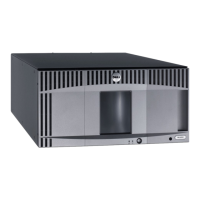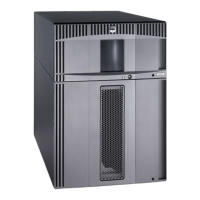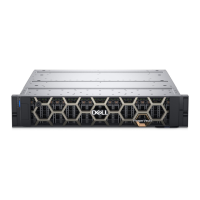Troubleshooting
file:///T|/htdocs/stor-sys/ML6000/en/html/ch09.htm[9/17/2012 1:50:53 PM]
Note: To display all closed tickets, select the Include Closed Tickets check box at the bottom of the screen. The
Tools - All RAS Tickets screen refreshes, with the Resolve button unavailable for all closed RAS tickets.
Caution: Be careful when pressing the Close All Tickets button. This closes all RAS tickets even if they are not
resolved. It is recommended that each RAS ticket be viewed, analyzed, and closed individually.
The path to open the appropriate screen is:
• From the Web client, select Tools > All RAS Tickets.
Capturing Snapshots of Library Information
Technical support personnel may ask you to perform the Capture Snapshot operation, so they can better diagnose issues. The
Capture Snapshot operation captures detailed information about the entire library in a single ASCII file that can be e-mailed
to technical support personnel.
The logged information consists of configuration data, status information, and trace logs for library components. Trace logs
collect problem data and provide support personnel with vital library information for troubleshooting and solving problems.
You can e-mail the Capture Snapshot file from both the operator panel and the Web client. On the Web client, you can also
download the Capture Snapshot file to a computer. You cannot download Capture Snapshot files from the library's operator
panel, and you cannot print Capture Snapshot files from either the Web client or the operator panel.
Depending on the library configuration and your connection speed, saving the Capture Snapshot file takes approximately 30
minutes. The resulting file size can be large. Your firewall file-size limitations could prohibit you from e-mailing the file.
On the Web client, ensure that the library e mail account is appropriately configured before you perform the Capture
Snapshot operation, so that the library can send Capture Snapshot files to the recipient. If the library e-mail account address
is not configured, an error appears. For information on setting up the e-mail account, see
Configuring the Library E-mail
Account.
The paths to open the appropriate screens are as follows:
• From the Web client, select Tools > Capture Snapshot.
• From the operator panel, select Tools > Capture Snapshot.
Saving and E-mailing the Library Configuration Record
The library configuration record is a text file that contains details about the library's configuration. The configuration record
can be saved or e mailed to a specified e-mail address. Information in the library. The configuration record includes:
• Product information—vendor, model, product ID, product version (library firmware version), and serial number.
• Capacity on Demand (COD) license information—licensed slots and expiration date.
• Module information—vendor, module type, module serial number, and module location coordinates.
• Tape drive information:
• SCSI tape drives—partition name, number of tape drives in partition, drive location, SCSI element address, online
status, active status, ready state, vendor, model, serial number, tape drive firmware version, drive type, logical
serial number, interface type, SCSI ID, and LUN.
• Fibre Channel (FC) tape drives—partition name, number of tape drives in partition, drive location, SCSI element
address, online status, active status, ready state, vendor, model, serial number, tape drive firmware version, drive
type, logical serial number, interface type, World Wide Node Name (WWNN) loop ID, topology, speed, and actual
speed.
Note: If the FC tape drive is attached to an FC I/O blade, the WWNN indicates the WWNN of the I/O blade, not
the tape drive.
• Serial Attached SCSI (SAS) tape drives—partition name, number of tape drives in partition, drive location, SCSI
element address, interface type, drive type, ready state, online status, barcode, media type, element address,
vendor, model, physical serial number, logical serial number, SCSI ID, firmware level, control path status.
• I/O blade information—blade number, blade ID, location coordinates, serial number, WWNN, firmware version, and

